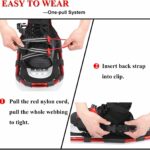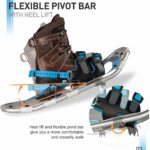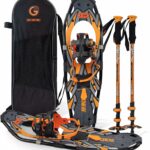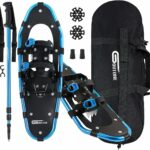Picture yourself gliding on snow-capped peaks, relishing the frosty air and the hum of your snowmobile – only to have the ride jarred by bumpy, unpredictable movements. This article guides you on how to identify if the shock of your beloved snowmobile has gone bad. Packed with tips and tricks, you’ll soon be an expert in diagnosing issues and maintaining the smooth operation of your winter ride. Buckle up and prepare to get your snowmobile on the go!
Understanding the Role of the Snowmobile Shock
Taking a stroll in the snow, light and fluffy, can be an amazing experience. But when it comes to speeding across the snowy terrain on a snowmobile, things get a bit more complicated. Especially when it comes down to the small yet critical component of your snowmobile – the shock.
Definition of a Snowmobile Shock
A snowmobile shock, also known as a shock absorber, is a vital component of the snowmobile’s suspension system. Simply put, it’s the job of the shock to absorb and dampen any bumps or unevenness in the path, providing you a stable and smooth ride.
The Importance of a Snowmobile Shock
The shock spells the difference between a bumpy and a smooth ride. It ensures that the wheels of your snowmobile stay in contact with the surface, reducing the chance of losing control. It also safeguards your snowmobile’s overall mechanism, by reducing the impact of shocks transmitted through the vehicle.
Common Types of Snowmobile Shocks
Generally, snowmobile shocks can be divided into two types – the first one is Hydraulic shocks, which are more traditional and usually found in older models. The second category is Gas shocks, which are more advanced and offer better performance. They primarily differ in the way they respond to repeated shocks and the damping capabilities they offer.
Common Symptoms of a Bad Snowmobile Shock
Just like any mechanical component, snowmobile shocks also wear out and show some symptoms. Identifying these symptoms early on can save your vehicle from further damage along with ensuring your safety.
Rough and Bumpy Ride
One of the key symptoms is when your ride turns rough and bumpy. This is because the shock is unable to absorb the impacts effectively, causing you to feel every bump or pothole on the terrain.
Reduced Control and Stability
If you’re experiencing an unusual, reduced control over your vehicle or if the snowmobile seems unstable, it might be due to a bad shock. The vehicle might sway or bounce excessively, endangering your safety.
Leaking Fluid
Noticing a fluid leakage near the shock area might indicate a blown seal or other internal damage within the shock absorber.
Visible Damage
Visible damage like a dent, bent shock body, or worn-out bushings are big red flags. In such cases, immediate action is required to avoid complications.
Unusual Noises
Unusually loud or constant noises during the ride could indicate a shock absorber that’s on its way out. This could be due to internal parts of the shock moving around loosely.
Analyzing Physical Signs of a Bad Snowmobile Shock
Even though some symptoms are prominent during a ride, some others are not readily evident. Keeping an eye on the physical signs can save you from unexpected troubles.
Spotting Leaks
Checking under and around the shock area for any oil or fluid leakage can indicate a faulty shock absorber.
Checking for Worn-Out Bushings
The bushings are an important part of the shock that provides cushioning. If they’re worn-out or damaged, this could lead to a loose shock and hence a rough ride.
Inspecting the Spring for Damage or Wear
The spring of the shock absorber is responsible for rebounding after absorbing impact. A damaged or worn-out spring can affect the functionality of the shock.
Dented or Bent Shock Body
Any visible deformities like dents or bends can affect the performance and potentially lead to a bad shock.
Effects of a Bad Snowmobile Shock on Ride Quality
Increased Ride Discomfort
With a faulty shock, every bump and unevenness of the terrain will be felt, making your ride a rather uncomfortable one.
Dangerous Swerving and Instability
A bad shock can lead to the snowmobile swerving dangerously or losing stability – not only reducing ride quality but also risking your safety.
Longer Stopping Distances
One of the lesser-known yet critical effects of a bad shock is increased stopping distance. Which means, you might take longer to stop the snowmobile, creating problematic situations, especially in emergencies.
The Importance of Regular Inspection and Maintenance
Like how you wouldn’t ignore your health check-ups, your snowmobile’s shock also deserves regular inspections and maintenance.
Routine Shock Checks
Regular checks can help identify potential issues at early stages, before they cause any serious problems.
When to Replace Shocks
Generally, shocks need to be replaced every few thousand miles, but each snowmobile is different and depends on factors such as the terrain driven often and the overall quality of the shock.
Proper Maintenance Practices
Maintenance practices like cleaning, tightening loose parts, checking bolts, and replacing worn-out parts can prolong the shock’s lifespan and efficiency.
The Dangers of Neglecting Shock Maintenance
Neglecting the maintenance of shocks can result in poor ride quality, increased discomfort, and potential accidents.
Tools Needed for Snowmobile Shock Inspection
You might need some tools to effectively inspect your snowmobile shock.
Basic Hand Tools
Basic tools like wrenches, sockets, and screwdrivers can come handy during the inspection process.
Specialty Tools for Shocks
Depending on the type and model of shock, you might need specialty tools for an in-depth check.
Safety Equipment
Safety gear like gloves and safety goggles to protect yourself is a must-have.
Inspection Procedures Using Tools
Knowing and following the correct use of each tool while performing the inspection is crucial to avoid adding to any damages.
How to Inspect a Snowmobile Shock
Reading Service Manual for Specific Procedures
Every vehicle comes with its own set of inspection procedures. Refer to the service manual of your snowmobile to become familiar with the specific inspection process.
Steps to Inspecting Shock for Damage
Detailed examination of components, noting any visible damage or unusual behavior; can help you spot a faulty shock.
Noting Any Unusual Performance Issues
While driving, if you notice any changes in the snowmobile’s performance, note them down for further inspection.
Identifying Signs of Wear or Damage
You should actively look for signs of wear and tear, or any damages on the shock.
Performing a Bounce Test on the Snowmobile
What is a Bounce Test?
A bounce test is a simple method to check the condition of your shock. It involves manually bouncing the snowmobile and observing the number of bounces it takes to come to a rest.
How to Perform a Bounce Test Correctly
By applying a downward force to the back of the snowmobile until it lowers, then release. Count the number of bounces it takes to rest. A healthy shock should come to rest within 1 to 2 bounces.
Interpreting Bounce Test Results
Continued bouncing indicates a worn-out or damaged shock, which should ideally be replaced soon.
How to Replace a Damaged Snowmobile Shock
Gathering Necessary Tools and Parts
First things first, gather all the necessary tools for the task, as well as the replacement part.
Step-by-Step Guide to Removing Old Shock
By following the service manual’s guide, carefully disassemble the old shock. Remember to note down the steps for ease of reassembly with the new shock.
Installation of New Shock
Installation is usually in the reverse order of disassembly. If any steps or components seem unclear, refer to the service manual or consult an expert.
Post-Installation Checks and Tests
Once the new shock is installed, you must run a few checks to ensure everything is perfectly in place, and the vehicle is ready for a run.
Troubleshooting a Bad Snowmobile Shock
Common Problems with Shocks
A few common problems include worn-out bushings, leaking fluid, and a dented shock body amongst others.
How to Diagnose Specific Shock Problems
Understanding the correlation between specific symptoms and the possible corresponding issues can help in diagnosing shock problems.
Possible Solutions and Fixes
Once a problem is diagnosed, depending on the severity, it could be a simple fix like tightening a bolt or might require a component change or, in worst cases, complete shock replacement.
Remember, a well-maintained snowmobile shock is not just about a smooth ride but also about your safety. So, make sure to take care of your vehicle and it will take care of your thrilling snow adventures!
- What Snowboard Bindings Should I Get? - January 23, 2024
- What Size Screws For Snowboard Bindings? - January 23, 2024
- How To Snowmobile On Water? - January 23, 2024










